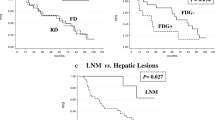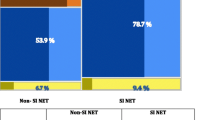Abstract
Purpose
We evaluated the activity and safety profile of 177Lu-Dotatate peptide receptor radionuclide therapy (Lu-PRRT) in patients with advanced, well-differentiated (G1-G2) gastrointestinal neuroendocrine tumors (GI-NETs).
Methods
Forty-three patients with radiological tumor progression at baseline and a positive Octreoscan® completed the treatment with Lu-PRRT, resulting in the cumulative activity of 18.5 or 27.8 GBq in five cycles. Total activity was scheduled on the basis of kidney function or bone marrow reserve.
Results
Twenty-five (58 %) patients were treated with a “standard” Lu-PRRT full dosage (FD) of 25.7 GBq (range 22.2-27.8), while the remaining 18 patients (42 %) who, at enrolment, showed a higher probability of developing kidney or bone marrow toxicity received a reduced dosage (RD) of 18.4 GBq (range 14.4-20.4). According to SWOG criteria, the overall response was complete response (CR) in (7 %) cases and stable disease (SD) in 33 (77 %), with a disease control rate (DCR) of 84 %. Median response duration was 25 months (range 7-50). Median progression-free survival (PFS) was 36 months (95 % CI 24-nr), and median overall survival (OS) has not yet been reached. Remarkably, none of the patients, including those at a higher risk of toxicity, showed side-effects after either dosage of Lu-PRRT.
Conclusion
Lu-PRRT was shown to be an effective therapeutic option in our patients with advanced progressive GI-NETs, showing an 84 % DCR (95 % CI 73-95) that lasted for 25 months and a PFS of 36 months. Both activities of 27.8 GBq and 18.5 GBq proved safe and effective in all patients, including those with a higher probability of developing kidney or bone marrow toxicity.




Similar content being viewed by others
References
Lawrence B, Gustafsson BI, Chan A, Svejda B, Kidd M, Modlin IM. The epidemiology of gastroenteropancreatic neuroendocrine tumors. Endocrinol Metab Clin North Am. 2011;40(1):1–18. vii.
Öberg K. Management of neuroendocrine tumours. Annals Oncol. 2004;15(4):293–8.
Rinke A, Muller H, Schade-Brittinger C, et al. Placebo-controlled, double-blind, prospective, randomized study on the effect of octreotide LAR in the control of tumour growth in patients with metastatic neuroendocrine midgut tumours: a report from the PROMID study group. J Clin Oncol. 2009;27:4656–63.
Kulke MH, Siu LL, Tepper JE, et al. Future directions in the treatment of neuroendocrine tumors: consensus report of the National Cancer Institute Neuroendocrine Tumor clinical trials planning meeting. J Clin Oncol. 2011;29:934–43.
Steinmuller T, Kianmanesh R, Falconi M, et al. Consensus guidelines for the management of patients with liver metastases from digestive (neuro)endocrine tumors: foregut, midgut, hindgut, and unknown primary. Neuroendocrinology. 2008;87:47–62.
Toumpanakis C, Meyer T, Caplin ME. Cytotoxic treatment including embolization/chemoembolization for neuroendocrine tumours. Best Pract Res Clin Endocrinol Metab. 2007;21:131–44.
Paganelli G, Zoboli S, Cremonesi M, et al. Receptor-mediated radiotherapy with 90Y-DOTA-D-Phe1-Tyr3-octreotide. Eur J Nucl Med. 2001;28(4):426–34.
Waldherr C, Pless M, Maecke HR, Haldemann A, Mueller-Brand J. The clinical value of [90Y-DOTA]-D-Phe1-Tyr3-octreotide (90Y-DOTATOC) in the treatment of neuroendocrine tumours: a clinical phase II study. Ann Oncol. 2001;12:941–5.
Bodei L, Cremonesi M, Grana C, et al. Receptor radionuclide therapy with 90Y-[DOTA]0-Tyr3-octreotide (90Y-DOTATOC) in neuroendocrine tumours. Eur J Nucl Med Mol Imaging. 2004;31:1038–46.
Kwekkeboom DJ, Muller–Brad J, Paganelli G. Overview of results of peptide receptor radionuclide therapy with 3 radiolabeled somatostatin analogs. J Nucl Med. 2005;46 Suppl 1:62S–6S.
Kwekkeboom DJ, de Herder WW, Kam BL, et al. Treatment with radiolabeled somatostatin analog [177Lu-DOTA0, Tyr3] Ocreotate: toxicity, efficacy and survival. J Clin Oncol. 2008;26:2124–30.
Imhof A, Brunner P, Marincek N, et al. Response, survival, and long-term toxicity after therapy with the radiolabelled somatostatin analogue [90Y-DOTA]-TOC in metastasized neuroendocrine cancers. J Clin Oncol. 2011;29:2416–23.
Klimstra DS, Modlin IR, Coppola D, Lloyd RV, Suster S. The pathologic classification of neuroendocrine tumors: a review of nomenclature, grading, and staging systems. Pancreas. 2010;39(6):707–12.
Cybulla M, Weiner SM, Otte A. End-stage renal disease after treatment with 90Y-DOTATOC. Eur J Nucl Med. 2001;28(10):1552–4.
Piccin A, Grana CM, Negri G, Pusceddu I, Paganelli G, Cortelazzo S. Secondary acute myeloid leukaemia after peptide receptor radionuclide therapy. Ann Hematol. 2012;91(2):299–300.
Bodei L, Cremonesi M, Ferrari M, et al. Long-term evaluation of renal toxicity after peptide receptor radionuclide therapy with 90Y-DOTATOC and 177Lu-DOTATATE: the role of associated risk factors. Eur J Nucl Med Mol Imaging. 2008;35(10):1847–56.
Bosman FT, Carniero F, Hruban RH, et al. WHO classification of tumours of the digestive system. 4th ed. Geneva: World Health Organization; 2010.
Binderup T, Knigge U, Loft A, Federspiel B, Kjaer A. 18 F-fluorodeoxyglucose positron emission tomography predicts survival of patients with neuroendocrine tumors. Clin Cancer Res. 2010;16:978–85.
Breeman WAP, de Blois E, Bakker WH, et al. Radiolabeling DOTA-peptides with 90Yand 177Lu to a high specific activity. In: Chinol M, Paganelli G, editors. Radionuclide peptide cancer therapy. New York, NY: Taylor & Francis Group; 2006. p. 119–26.
Green S, Weiss GR. Southwest oncology group standard response criteria, endpoint definitions and toxicity criteria. Invest New Drugs. 1992;10:239–53.
van Vliet EI, Krenning EP, Teunissen JJ, Bergsma H, Kam BL, Kwekkeboom DJ. Comparison of response evaluation in patients with gastroenteropancreatic and thoracic neuroendocrine tumors after treatment with [177Lu-DOTA0, Tyr3]octreotate. J Nucl Med. 2013;54(10):1689–96.
Common Terminology Criteria for Adverse Events v3.0 (CTCAE, http://ctep.cancer.gov/protocolDevelopment/electronic_applications/docs/ctcaev3.pdf
Kaplan EL, Meier P. Non parametric estimation for incomplete observation. J Am Stat Assoc. 1958;53:457–81.
Lawless JS. Statistical models and methods for life-time data. New York, NY: Wiley; 1982.
Bodei L, Cremonesi M, Grana CM, et al. Peptide receptor radionuclide therapy with (177)Lu-DOTATATE: the IEO phase I-II study. Eur J Nucl Med Mol Imaging. 2011;38:2125–35.
Sandström M, Garske-Román U, Granberg D, et al. Individualized dosimetry of kidney and bone marrow in patients undergoing 177Lu-DOTA-octreotate treatment. J Nucl Med. 2013;54(1):33–41.
Wessels BW, Konijnenberg MW, Dale RG, et al. MIRD pamphlet No. 20: the effect of model assumptions on kidney dosimetry and response—implications for radionuclide therapy. J Nucl Med. 2008;49:1884–99.
Severi S, Nanni O, Bodei L, et al. Role of (18)FDG PET/CT in patients treated with (177)Lu-DOTATATE for advanced differentiated neuroendocrine tumours. Eur J Nucl Med Mol Imaging. 2013;40(6):881–8.
Garin E, Le Jeune F, Devillres A, et al. Predictive value of 18 F-FDG PET and somatostatin receptor scintigraphy in patients with metastatic endocrine tumors. J Nucl Med. 2009;50:858–64.
Claringbold PG, Brayshaw PA, Price RA, Turner JH. Phase II study of radiopeptide 177Lu-octreotate and capecitabine therapy of progressive disseminated neuroendocrine tumours. Eur J Nucl Med Mol Imaging. 2011;38:302–11.
A Study Comparing Treatment With 177Lu-DOTA0-Tyr3-Octreotate to Octreotide LAR in Patients With Inoperable, Progressive, Somatostatin Receptor Positive Midgut Carcinoid Tumours (NETTER-1). ClinicalTrials.gov Identifier: NCT01578239.
Acknowledgements
This study was partially supported by grants from the Italian Association for Cancer Research (AIRC) and the Istituto Oncologico Romagnolo (IOR).
Conflict of interest
The authors declare that they have no conflicts of interest.
Author information
Authors and Affiliations
Corresponding author
Rights and permissions
About this article
Cite this article
Paganelli, G., Sansovini, M., Ambrosetti, A. et al. 177 Lu-Dota-octreotate radionuclide therapy of advanced gastrointestinal neuroendocrine tumors: results from a phase II study. Eur J Nucl Med Mol Imaging 41, 1845–1851 (2014). https://doi.org/10.1007/s00259-014-2735-5
Received:
Accepted:
Published:
Issue Date:
DOI: https://doi.org/10.1007/s00259-014-2735-5




